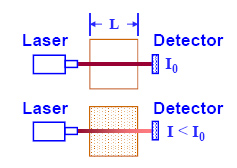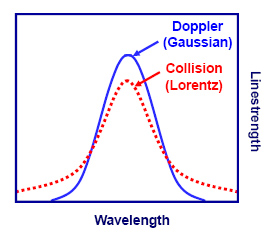Laser Absorption
 Diode laser absorption spectroscopy utilizes knowledge of absorption linestrengths and lineshapes for measurements of species concentrations and temperatures. As shown in Fig. 1, laser light is passed through the test gas and the transmitted light, I, is normalized to the laser signal measured without test gas, I0.
Diode laser absorption spectroscopy utilizes knowledge of absorption linestrengths and lineshapes for measurements of species concentrations and temperatures. As shown in Fig. 1, laser light is passed through the test gas and the transmitted light, I, is normalized to the laser signal measured without test gas, I0.
Fig. 1. Schematic for TDLAS. The signal attenuated by absorption (bottom) is normalized by a reference signal (top).
The normalized signal, I/I0, is exponentially dependent on path length through the test gas as well as the absorption ceoefficient where:

 The wavelength of the laser is then tuned across atomic or molecular transitions and the resulting lineshapes are recorded, as shown in Fig. 2. For atmospheric pressure flames, linewidth variations are dominated by the effects of temperature, allowing simultaneous temperature and species concentration measurements.
The wavelength of the laser is then tuned across atomic or molecular transitions and the resulting lineshapes are recorded, as shown in Fig. 2. For atmospheric pressure flames, linewidth variations are dominated by the effects of temperature, allowing simultaneous temperature and species concentration measurements.
Fig. 2. Line profiles broadened by temperature (Doppler effect) and pressure (collisions).
Spectral Energies, LLC is developing new technologies in diode laser absorption spectroscopy and achieving ground breaking results in high-speed detection and measurement accuracy.
